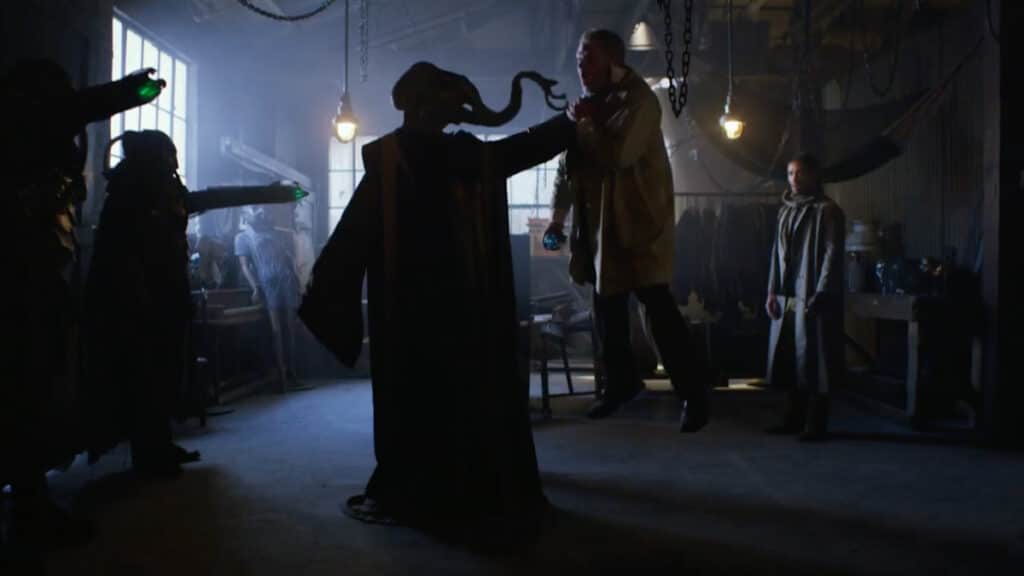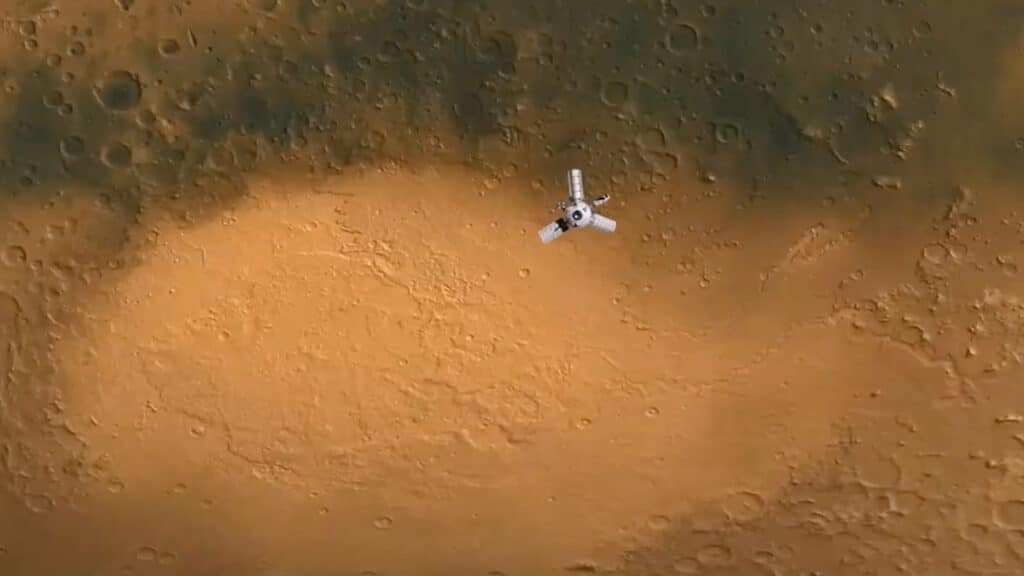Battle in Space: The Armada Attacks (2021) is an anthological, science-fiction film. The various segments were written by Josh Guttman, Andrew Jaksch, Lukas Kendall, Sanjay F. Sharma, and Luis Tinoco. The segments were directed by Andrew Jaksch, Lukas Kendall, Toby Rawal, Scott Robson, Sanjay F. Sharma, and Luis Tinoco.
Set in the year 2420, Battle in Space: The Armada Attacks tells a series of five separate stories centered on a selection of human rebels. Apparently in 2420, Earth has been colonized by a bunch of aliens, and space wizards, who have enslaved the human race. These rebels are not connected to each other in any way, other than that they are all similarly suffering the injustices of their extraterrestrial masters. Each one, in turn, engages in some act of defiance, unwilling to be passive and let the invaders decide their respective fates.

The first story, set in a dystopian Blade Runner-esque (Ridley Scott, 1982) slum, is about an ex-cop, cum private detective who, against his better judgement, attempts to find and rescue a child from the hands of kidnappers.
The second tells the tale of two guys, one of whom is apparently force-sensitive, who are trying to steal a crystal from a warehouse.
The third focuses on a mission to Mars that inadvertently goes off the rails when it becomes menaced by bizarre, and Hellish circumstances, not totally unlike those Sam Neill experienced in Event Horizon (Paul W.S. Anderson, 1997).
The fourth story deals with the pilot of a spaceship, who awakes from some kind of coma to find that things aren’t quite as he remembered them. His co-pilot, whom he is instantly suspicious of may or may not be an enemy spy. It is his job to figure it out quickly, lest dire consequences befall the ship, and indeed the resistance.
The final story depicts a teenage girl, and her pre-teen brother who have suffered a major car accident. The girl makes it, the boy does not. Wracked with guilt and remorse over her perceived responsibility for his death, the sister will stop at nothing to see her late brother’s final wish through to fruition.
Anthology films are an interesting breed. There is as much to like about them as there is to not like about them. Sometimes, anthology films hit a grand slam. Creepshow (George A. Romero, 1982), Dead of Night, (Alberto Cavalcanti, Charles Chrichton, Basil Dearden, Robert Hamer, 1945), Four Rooms (Allison Anders, Alexandre Rockwell, Robert Rodriguez, Quentin Tarantino, 1995), and Black Sabbath (Mario Bava, 1963), are all, in my opinion, fantastic examples of the anthology format firing on all cylinders. There are more, but you get the point.
In these kinds of anthology films, there is a cohesion to the various segments that allows the whole thing to feel like a single cinematic experience, in spite of the piecemeal approach to the way the story is told. When it works, it’s brilliant.
Additionally there is something about knowing that the story will be told in small, separate, easily digestible chunks, that makes the consumption of an anthology film somehow easier than the consumption of one single story. Perhaps this is something I should be ashamed of. I pride myself on being able to take down the lengthiest of films with aplomb.
However, like so many other folks on this planet, I too occasionally struggle with attention deficit issues. Sometimes, when I’m trying to check into a film, my brain has other plans, and it won’t allow me to pay a film the due diligence that it deserves. Don’t know how or why this happens, but that has no bearing on the fact that it does.
When I sit down to watch an anthology film, I breath a little sight of relief. I know that no single story will be so lengthy or meaty that I need to pay as rapt attention to every single detail as I might with a story that is feature length. The shorter runtime automatically precludes the thing from being too dense. My brain doesn’t have a chance to prevent me from checking in. The vignettes are too short!
Unfortunately, as someone who has rallied for almost their entire life against the notion that movies are something for which people want to “turn their brains off and enjoy,” this phenomenon makes me feel slightly hypocritical. It is at these times I must remind myself that I am only human, and thus allowed a modicum of hypocrisy. But I digress.
There are times when the anthology film doesn’t achieve the kind of cohesion that one needs for a completely fulfilling cinematic experience. While the varied nature of their content ensures that not every part of the film sucks, the components that fail drag the rest of the film down. Spirits of the Dead (Roger Vadim, Louis Malle, Frederico Fellini, 1968) Twilight Zone: The Movie (John Landis, Steven Spielberg, Joe Dante, George Miller, 1983), and Three… Extremes (Fruit Chan, Park Chan-wook, Takashi Miike, 2004), are all films that feature some brilliant work, alongside some less than brilliant work. Worth watching, but ultimately not as satisfying as you would have hoped they would be, based on the talent behind the camera.
And then there are those that are either total garbage, or only worth watching for their novelty. Movie 43 (too many directors to bother with, 2013), and Night Train to Terror (John Carr, Phillip Marshak, Tom McGowan, Gregg C. Tallas, 1985) are both primo examples of this phenomenon.
And then there are those that are either total garbage, or only worth watching for their novelty. Movie 43 (too many directors to bother with, 2013), and Night Train to Terror (John Carr, Phillip Marshak, Tom McGowan, Gregg C. Tallas, 1985) are, respectively, primo examples of this phenomenon.

Now that I have concluded this very brief, yet still overlong crash course on anthology pictures, can you guess which one of the three tiers Battle in Space: The Armada Attacks belongs in? You needn’t wait until the end, I’ll tell you now. It’s the second tier.
When the movie first started, I must admit, I was rolling my eyes hard. As the opening narration gave way to the first vignette, I was girding my loins for the certain-to-be unbearable 90 minutes to follow. In the first few minutes, I saw little to convince me otherwise. However, as the first chapter played out, while neither the story nor the acting was very good, I did notice that the production values seemed oddly high. The costumes, locations, and special effects were all pretty impressive.
At this point I had no idea this was an anthology film. Needless to say that by the time the first chapter concluded, I felt the pacing of the movie was weird. No shit. That’s because this is an anthology film! Something I realized about halfway through the second story. A story, that I might as well tell you now is the worst part of the film entirely. Apologies to whichever of the filmmakers were behind this one, but the second section stinks on ice.
The second story, which deals with two dudes trying to steal a crystal from a warehouse is not good. It has the shittiest production values of the entire film, hands down. Nothing works in this part. Poor story, unlikable/bad actors, confusing, and irritating, this chapter would have been best left in the first-semester student film festival that the producers must have found this thing in. I don’t want to go into too much detail, for there are still three other stories. However, I found myself wondering if I should be thankful that they put the turd so close to the front of the film so you could get it out of the way, and onto better things quicker.
The third story is not only the most ambitious of the entire film, but this thing looks like they spent a shitload of money on it. Respective to the rest of the material in the film, of course. Sadly, while this section did get cool points for ambition and execution, it also suffers from its ambitiousness. It felt like it wanted to be a child of headier sci-fi. Stuff like 2001: A Space Odyssey (Stanley Kubrick, 1968), High Life (Claire Denis, 2018), and Interstellar (Christopher Nolan, 2014) seemed likely to be high on the list of the favorite films of the writer and/or director (assuming they are different people).
However, those films this one ain’t. While the costumes, sets, acting, cinematography, and special effects were all impressive in this one, the story just wasn’t there. It just constantly felt like it was trying to be like something else, without really knowing what it was on its own. It was pretty to watch, obviously crafted by many skilled hands, but other than that, this chapter had little else going for it.
The fourth story was basically Lifeboat (Alfred Hitchcock, 1944) in space, if it were abridged for television. This is not a slam, as this vignette might very well be the best of the bunch. The simple premise, believable acting, and bitchin’ looking set made it easy for me to be drawn into the drama, and kept me guessing the whole time. Is she? Isn’t she? She is, I knew it! Wait, no she isn’t. I knew it! This was the first, and possibly only segment in the film I had no real gripes about. This one is good.
The final segment was probably the most confusing of the bunch. Not confusing in terms of the story or the way it is told. Confusing because the production values seem so shitty, that by the time it concludes, I was surprised to find myself pleased with the story. It’s like the opposite of almost every chapter in this film. Instead of it having great production values but a shitty story, it had shitty production values, but a good story. It was slightly ambitious as well, adding a subplot that was more meta than I expected.
Actually, I’d like to make a bit of a correction here. This last story is really made up of two separate, yet conjoined storylines. One of which has superb production values, the other, borderline atrocious. And yet the story works. It works on its own, and it works as an appropriate cap to everything we have been through thus far. It worked so well, that by the end I was reconsidering all of the opinions I had formed about Battle in Space: The Armada Attacks.
Time to wrap this up.

I found Battle in Space: The Armada Attacks to be a fascinating mix of good and bad. The good parts were better than they had any right to be, and the bad parts were as bad as you would expect. I must say, I’m not quite sure who this movie is for. I know there are action film fans and horror film fans that love the genre itself so much that they will consume anything they can get their hands on, and will judge them according to their love of genre, not using the same standards someone with less specific tastes, and less specific insights would. Are there sci-fi fans like this as well?
Battle in Space: The Armada Attacks seems like the kind of movie that would debut unceremoniously on the new release wall at the Blockbuster I used to work at, and go largely unseen. Like Transmorphers (Leigh Scott, 2007), or Hoodrats 2: Hoodrat Warriors (Edgar Arellano, 2008). Something that only my customers with monthly movie-passes would rent. Because, why the fuck not? They’ve already rented everything else in the store.
However, Battle in Space: The Armada Attacks is worth watching for a number of reasons. Not the least of which is the bizarre combination of the expensive-looking and the cheap-looking elements that somehow manage to coexist in the same film. It is an uneven watch to be sure, and I don’t mean to extend it more credit than it is due.
There is plenty to not like here. At its worst, Battle in Space: The Armada Attacks is amateurish, and derivative. However, there are certain moments in which the film shines just as brightly as it stinks in the moments that it tanks. The film is particularly successful on its technical merits.
I would not recommend this film to everybody. It isn’t good enough for most to appreciate it, and it isn’t bad enough to become a Night Train to Terror-style cult classic. However, if you like independent cinema, are a major sci-fi head, or an anthology junkie, there is as much to like in this film as there is to not like. Honestly, probably more to like. Following its conclusion, I found myself surprisingly impressed with more of the film than I could have expected. Impressed enough that I knew reviewing it was going to be tough. There is a lot of heart on display here.
They say the road to Hell is paved with good intentions. Battle in Space: The Armada Attacks is an interesting, if at times confounding, cinematic manifestation of this very axiom. For the film fans whose tastes skew more normie than others, I’d give Battle in Space: The Armada Attacks a miss. However, for the more adventurous, and/or for the less discerning, Battle in Space: The Armada Attacks is likely worth the rental fee. And if you paid for it, and you didn’t think it was worth it, at least you can feel good knowing you supported independent art. And maybe, just maybe, your support will translate into a green-light for another piece of independent cinema that might be more to your liking.
P.S. Apparently, Four Rooms was neither well received by critics, nor does it boast a reputation that is commensurate with the opinion that I have recently expressed. All I can say is, I don’t know what movie the people that don’t like it have been watching, however their negative opinions of Four Rooms are incorrect. That movie is rad. Just because two of the vignettes are amazing in a way the other two are not, does not make the other two bad. They are simply less amazing. But don’t believe me, why not check it out for yourself? Also, Combustible Edison’s score is positively magnificent. They should have been nominated for an Oscar for it. #RIPCombustibleEdison
Review
Rating
RN Review of Battle in Space: The Armada Attacks
For the film fans whose tastes skew more normie than others, I'd give Battle in Space: The Armada Attacks a miss.



